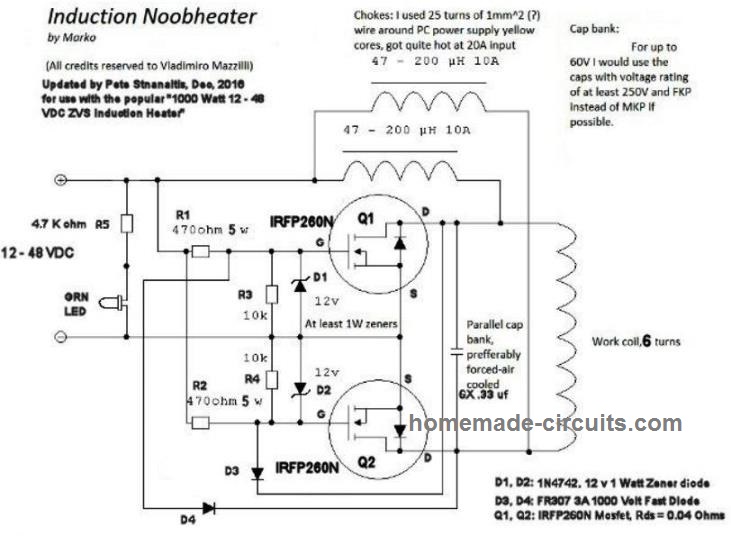Let us build a full ZVS driver + tank circuit simulator super useful for trying different values of voltage, frequency, inductor, capacitor, and seeing how your ZVS-based induction heater behaves.

What This Simulator Does:
Calculates:
- Resonant frequency (f)
- Required inductance (L)
- Tank current (approximate)
- Reactive power (Q-factor)
- Heating efficiency range estimate
- Shows warnings if parameters are unsafe
ZVS Induction Heater + Tank Circuit Simulator
How It Works Behind the Scenes:
- Z = Xl - Xc → reactance difference creates the LC resonance tank
- I = V / Z → approx current in the LC loop (not including switching losses)
- Q = Xl / Z → higher Q means sharper resonance and better energy recycling
- Reactive Power shows how much VA is circulating (not real power)
Design Tips for Best Results:
| Parameter | Recommended Value |
|---|---|
| Frequency (f) | 50kHz to 200kHz |
| Capacitance (C) | 0.1 to 2 µF (MPP/MKP type) |
| Inductance (L) | 1 to 20 µH (air-core or copper tubing) |
| Voltage (V) | 12V to 36V (ZVS driver safe range) |
| Tank Current (I) | Preferably try to Keep under 30 A unless heavy copper used |
How You Can Keep Tank Current Below 30 Amps:
Move Slightly Away from Resonance (Detuning)
Tank current goes to peak only at exact resonance. If you shift the frequency a bit above or below resonance then current drops without killing heating.
Example:
Resonance at 100 kHz
Try operating at 105–110 kHz or 95–90 kHz
This reduces I = V / (Xl - Xc) because Xl ≠ Xc anymore.
Increase Net Reactance (Z = Xl - Xc)
Your current is high because:
Z = |Xl - Xc| is very small → I = V / Z becomes very very big...To increase Z and reduce current, you can:
a. Reduce Capacitance
Use lower value capacitor. For example:
- Instead of 0.33 µF, Try 0.1 µF.
This increases Xc which increases |Xl - Xc| → lowers current
b. Increase Inductance
Use slightly more turns or wider coil
- Instead of 7.6 µH, Try 15 µH.
This increases Xl which helps in detuning and results in less current.
Try keeping Z around 0.8 Ω minimum
So for 24V:
I = 24 / 0.8 = 30 ALower the Supply Voltage
Tank current is directly proportional to voltage:
I = V / ZSo instead of 24V we can use 12V:
- 12V supply
Same Z = 0.05 Ω
Now I = 12 / 0.05 = 240 A (still high, but 50% lower than 24V case)
But better if you combine lower voltage + detuning → then real current can go under 30A.
Add a Small Series Resistance (Lossy Method)
This is a crude method but works:
- Add 1 to 2 Ω high-watt resistor in series with tank.
- Will limit current but waste energy as heat.
- Use only for small systems, not recommended for powerful heaters.
Use PWM Controlled Supply Instead of Constant Voltage
If you use a PWM buck converter to softly power the ZVS circuit then you can:
- Limit the average input voltage
- Use a current sensor to cut power at 30A
- Gradually ramp up to avoid peak surges
This gives full control like a professional induction heater.
Need Help? Please Leave a Comment! We value your input—Kindly keep it relevant to the above topic!